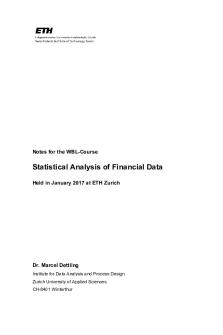Descriptive Statistics PDF

| Title | Descriptive Statistics |
|---|---|
| Course | Psychology |
| Institution | University of South Wales |
| Pages | 3 |
| File Size | 99.7 KB |
| File Type | |
| Total Downloads | 18 |
| Total Views | 194 |
Summary
Revision for OCR Component 1...
Description
Descriptive Statistics
Measures of Central Tendency:
Mode Median Mean
Measures of Dispersion:
Range Variance Standard deviation
Mean - the mean is the arithmetic average that indicates the typical score in a data set How to calculate - you add all of the data and divide by how many there are Example - 9 6 3 1 9 5 6 2 4 8 5 9 6 4 3 1 8 5 7 = 101 / 19 = 5.3
Median - this is the middle number when all of the numbers are in order from lowest to highest How to calculate - line up the numbers in order and find the middle number Example - 1 1 2 3 3 4 4 5 5 5 6 6 6 7 8 8 9 9 = 5
Mode - this is the most common or frequent number, sometimes data can be bimodal (more than 1) How to calculate - count up how many of each number there are Example - 1 1 2 3 3 4 4 5 5 5 6 6 6 7 8 8 9 9 - mode is 5 and 6
Range - the simplest measure of a spread of data, which looks at the spread of results How to calculate - take the smallest result from the largest Example - 9 - 1 = 8
Variance - considers the difference between each piece of data and the mean How to calculate -
Σ ( x−x ) ² N −1
Example - mean = 5.3 and scores = 19 x 1 1 2 3 3 4 4
X - x -4.3 -4.3 -3.3 -2.3 -2.3 -1.3 -1.3
(x - x )2 -18.49 -18.49 -10.89 -5.29 -5.29 -1.69 -1.69
-0.3 -0.3 -0.3 +0.7 +0.7 +0.7 +1.7 +2.7 +2.7 +3.7 +3.7
5 5 5 6 6 6 7 8 8 9 9
-0.09 -0.09 -0.09 0.49 0.49 0.49 2.89 7.29 7.29 13.69 13.69
= 27.16 / (19 - 1) = 1.51 = S2
Standard Deviation - a quantity expressing by how much the members of a group differ from the mean value for the group How to calculate - square root your answer for the variance Example - variance = 1.51 = S2 Square root it so S = 1.23
Fractions - a proportion of an amount Decimal Form - where the denominator is a powerful of 10 Standard Form - you take a very large number and shorten it Percentage - a rate out of 100 Ratio - the relation between two amounts Significant Figures - the most important digit
Graphs
Bar Charts:
Used when the data is in separate categories Used to show totals and all measures of central tendencies Bars must be separate and not touching IV along the X axis and DV along the Y axis Must have a title and labelled axes
Pie Charts:
A circular graph divided into sections Each portion of the circle represents numerical proportions Each 1% of your date is given a 3.6o of the circle You need a protractor to draw an accurate pie chart
Histograms:
Are used to show the pattern in whole sets of data Where data is continuous May also be used to illustrate the distribution of a set of scores The DV is plotted along the X axis The frequency of each score is plotted up the Y axis Scores on the X axis may be grouped Because the scale is continuous, the bars can touch
Line Graph:
Are just an alternative way than a histogram to show frequencies The points are drawn where the scores on the X and Y axis meet These points are then joined to form a line A smooth line with an equal amount of points on each side is called the line of best fit
Scatter Graph:
A graph that shows the correlation between two data sets Plot the various points across the graph The dots indicate the degree of correlation between the variables A positive correlation goes from bottom to top A negative correlation goes top to bottom Zero correlation is where there is no correlation between the two variables...
Similar Free PDFs

Descriptive Statistics
- 3 Pages

Descriptive Statistics
- 2 Pages

Descriptive Statistics
- 23 Pages

Descriptive Statistics
- 5 Pages

Week 4: Descriptive Statistics
- 9 Pages

Descriptive Statistics CH 4
- 2 Pages

descriptive statistics Ch 2
- 90 Pages

W3 Descriptive Statistics
- 3 Pages

Module 3: Descriptive Statistics
- 2 Pages

Descriptive Statistics Understanding
- 47 Pages
Popular Institutions
- Tinajero National High School - Annex
- Politeknik Caltex Riau
- Yokohama City University
- SGT University
- University of Al-Qadisiyah
- Divine Word College of Vigan
- Techniek College Rotterdam
- Universidade de Santiago
- Universiti Teknologi MARA Cawangan Johor Kampus Pasir Gudang
- Poltekkes Kemenkes Yogyakarta
- Baguio City National High School
- Colegio san marcos
- preparatoria uno
- Centro de Bachillerato Tecnológico Industrial y de Servicios No. 107
- Dalian Maritime University
- Quang Trung Secondary School
- Colegio Tecnológico en Informática
- Corporación Regional de Educación Superior
- Grupo CEDVA
- Dar Al Uloom University
- Centro de Estudios Preuniversitarios de la Universidad Nacional de Ingeniería
- 上智大学
- Aakash International School, Nuna Majara
- San Felipe Neri Catholic School
- Kang Chiao International School - New Taipei City
- Misamis Occidental National High School
- Institución Educativa Escuela Normal Juan Ladrilleros
- Kolehiyo ng Pantukan
- Batanes State College
- Instituto Continental
- Sekolah Menengah Kejuruan Kesehatan Kaltara (Tarakan)
- Colegio de La Inmaculada Concepcion - Cebu





